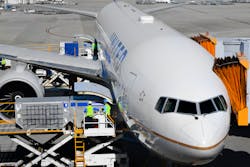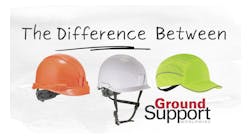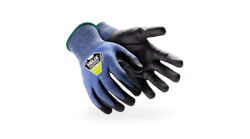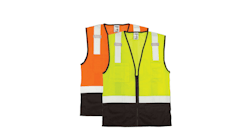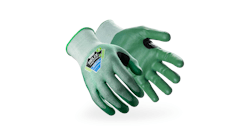The importance of safety on the ramp cannot be overstated. Ground handling operations and the use of ground support equipment are subject to various levels of safety oversight.
Chief among these measures is the use of safety apparel to protect personnel while they service aircraft. High visibility safety apparel (HVSA), in particular, decreases the likelihood of injuries to ground handling personnel working in the busy airport environment, especially as GSE and aircraft move throughout the area.
“High visibility garments should be chosen after a basic hazard assessment has been completed by a trained person designated by the employer, taking into account the expected threat environment, work activities, competing hazards, job classifications and use policies,” say officials at R&R Industries.
To protect ground service providers and others employed at an airport, R&R Industries produces high-visibility safety vests, hooded sweatshirts, crew sweatshirts, jackets, rain jackets, rain pants, t-shirts and gators in various styles and with multiple features to suit specific applications.
“We started manufacturing high visibility apparel about 20 years ago,” says Jeanne Hardwegg, national accounts manager at R&R Industries, adding high visibility clothing was added to the product line at the request of its customers.
“One of our customers that was a national account specifically requested anti-static safety vests for their fuelers,” she adds. “That is when we developed an ANSI Class II Anti-Static Safety Vest.”
R&R Industries’ HVSA is manufactured to standards established by the American National Safety Institute (ANSI).
Per the ANSI, high-visibility safety apparel provides visibility during day or night, which is vital in hazardous conditions or where threats may be present. The standard takes into effect the color of the clothing, retroreflection and the recommended configuration of the materials, among others.
R&R Industries’ Type R HVSA is designed for occupational use in proximity to roadways.
“Type R HVSA provides daytime and nighttime visual conspicuity enhancement for workers in occupational environments, which include exposure to traffic (vehicles using the highway for purposes of travel) from public access highway rights-of-way or roadway temporary traffic control (TTC) zones, or from work vehicles and construction equipment within a roadway temporary traffic control (TTC) zone,” officials at R&R Industries note.
“The Type R designation includes multiple Classes of HVSA. Examples of pedestrian workers intended for this HVSA Type may include all the workers required to comply with United States Federal Regulations on worker visibility in the Manual on Uniform Traffic Control Devices (MUTCD), who are operating on or near public access roadways,” company officials add.
“If fueling, customers should confirm the correct clothing, shoes and vest are being used,” Hardwegg advises.
In addition to visibility benefits, safety apparel provides personnel comfort and safety in various climates and weather conditions.
Hi-Visibility Apparel can require specific care. But officials at R&R Industries say the tag in each item of clothing explains all necessary cleaning requirements.
Because of the harsh environments in which HVSA is utilized, the average lifespan of a piece of clothing can fluctuate between 3-6 months. Hardwegg notes R&R Industries offers a 1-year warranty for workmanship, as well as customization.
“We do all of the decoration, screen printing, embroidery, heat transfer in our building,” she explains. “We are able to keep the integrity of companies’ logos.”
As an added convenience for customers, website stores allow safety managers to place orders for HVSA whenever it is needed.
To complement its apparel offerings, R&R Industries also provides related safety gear, including marshalling wands, thermometers, gloves, masks, ear protection, goggles and whistles.
